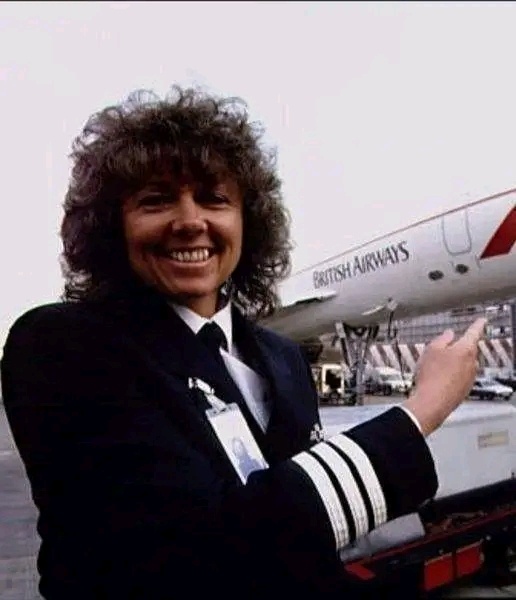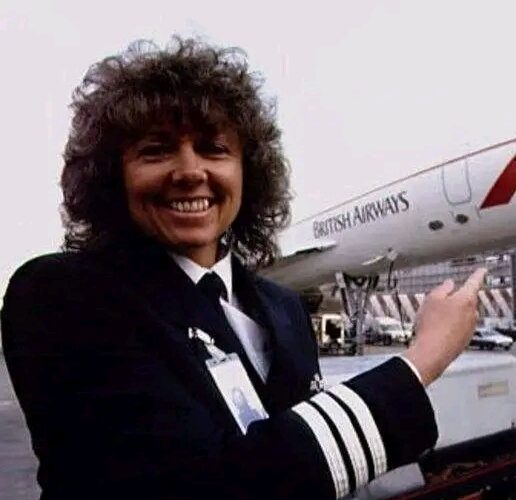From hairdresser to Concorde pilot: remembering Barbara Harmer

As I sat with my store-worker parents in a crowded hall on my first day of secondary school, the headmistress’s words stung: “Any wannabe hairdressers or store workers, please get up and leave now.” I glanced at my parents, who exchanged a look. To her, perhaps, our backgrounds didn’t fit the mold of “success.” Yet, it was their hard work that instilled in me a drive to achieve.
That same drive led me to excel in school and sparked my interest in aerospace engineering—a field I pursued after being captivated by Concorde. Along this path, I found a role model in Barbara Harmer, the only woman to ever pilot Concorde for British Airways, and someone who embodied the power of persistence.
Barbara Harmer’s Early Life and Journey to Aviation
Barbara Harmer’s journey to becoming Concorde’s first female pilot is as remarkable as it is unconventional. Leaving school at 15, her options were limited, and like many young women at the time, she became a hairdresser. Yet, after five years in the field, she realized that her aspirations extended beyond the salon. Fueled by ambition, she made a bold shift to aviation, starting out as a trainee air traffic controller at Gatwick Airport. Determined to advance further, Barbara enrolled in A-level courses, setting her on an unexpected path.
Not long after, she earned her Private Pilot’s License and began instructing at Goodwood Flight School. But Barbara’s goals were clear: she aspired to be a commercial pilot. To make this dream a reality, she took out a £10,000 loan to fund her training, a significant financial risk but one that would ultimately lead her to a groundbreaking career. In 1982, she obtained her Commercial Pilot’s License, taking her one step closer to the cockpit of a commercial airliner.
Breaking Barriers as a Woman in Aviation
Despite her qualifications, Barbara faced formidable challenges in the male-dominated world of aviation. She submitted over 100 job applications before finally securing a position at Genair, a small airline that later went bankrupt. Her resilience, however, paid off when she joined British Caledonian, which was later acquired by British Airways. By then, Concorde had been in service for over a decade, its elite crew consisting of some of the best pilots. At the time, British Airways employed around 3,000 pilots, of which only 60 were women.
Barbara defied the odds and was hand-picked by British Airways for the elite Concorde crew. Her skill and dedication impressed her superiors, allowing her to undergo six months of rigorous training. In 1993, she made history by flying Concorde from London Heathrow to New York’s JFK Airport, becoming the first and only woman to pilot the supersonic aircraft for British Airways.
Captain Harmer’s Legacy in Aviation
Barbara’s journey made her a celebrated figure among her peers and in the aviation community. Known for her warmth and professionalism, she became well-loved among her colleagues and crew. One of her most memorable flights involved transporting Manchester United’s football team to their Champions League final in Barcelona in 1999. Reflecting on that experience, she later stated, “I felt thrilled and honoured to be asked to fly the team… quite emotional as I taxied the Concorde out to the runway with British flags flying and thousands of people wishing the team luck.”
After Concorde’s retirement in 2003, Barbara continued her career as a captain on other British Airways aircraft until her retirement in 2009. Sadly, she passed away in 2011, but her legacy continues to inspire countless young women interested in aviation.
The Struggles of Women in Male-Dominated Industries
Barbara Harmer’s story is one of determination, resilience, and skill—a story that should be more widely known. During my research, I discovered a rare photograph of her meeting Jo Salter, the RAF’s first female Tornado fighter pilot, both women sitting with Concorde and a Tornado jet in the background. Shockingly, many online comments were filled with dismissive remarks, undermining their achievements with jokes about needing men to park the planes. Despite the strides women have made, such attitudes persist, highlighting the barriers that female pilots still face.
It’s disappointing that Barbara Harmer’s story has not received greater recognition, even in media covering Concorde’s history. Out of the many Concorde books I’ve collected, not one mentions her name. It was only through a determined search that I stumbled upon her inspiring journey. Women like Barbara deserve more visibility in modern discourse, and her story offers a role model for young girls aspiring to enter fields like aerospace and engineering.
Women like Barbara Harmer demonstrate that it’s possible to defy expectations and achieve greatness, regardless of one’s beginnings. She, and countless other women, serve as bright examples for young girls, and I am hopeful that her legacy will inspire future generations of female pilots, engineers, and leaders.
So, to the headmistress who doubted the “wannabes” in her school hall: there’s more to success than one’s background. A woman can start as a hairdresser and end up flying Concorde. That’s the legacy of Barbara Harmer—a legacy worth celebrating and remembering.
FAQ about Barbara Harmer and her legacy in aviation
1. Who was Barbara Harmer?
Barbara Harmer was a British pilot and the first and only woman to fly the supersonic Concorde jet for British Airways. She broke significant barriers in aviation, moving from an early career as a hairdresser to becoming a pioneering female pilot in a male-dominated field.
2. What inspired Barbara Harmer to become a pilot?
After working as a hairdresser for several years, Barbara realized she wanted more from her career. Her interest in aviation led her to train as an air traffic controller and later pursue her pilot’s licenses, driven by a deep ambition to fly commercially.
3. How did Barbara Harmer qualify to fly Concorde?
Barbara obtained her Commercial Pilot’s License after taking out a loan to fund her training. She initially gained experience flying for small airlines and worked her way up to British Caledonian, which was later acquired by British Airways. Due to her skills and dedication, she was eventually selected for Concorde’s exclusive crew and underwent six months of specialized training to qualify.
4. When did Barbara Harmer make her first Concorde flight?
Barbara Harmer made her historic Concorde flight in 1993, flying from London Heathrow to New York’s JFK Airport. This flight marked her as the first and only woman to pilot Concorde for British Airways.
5. What challenges did Barbara face in her career as a female pilot?
Barbara faced numerous obstacles, including difficulty securing her first job as a pilot. She submitted over 100 applications before landing a position. Even after joining the ranks of British Airways pilots, she worked in a highly male-dominated field where only a small percentage of pilots were women, often encountering stereotypes and biases.
6. Why is Barbara Harmer’s legacy significant?
Barbara’s story is a testament to resilience, ambition, and breaking gender barriers. As a trailblazer in aviation, she serves as an inspiration for women in fields traditionally dominated by men, particularly those aspiring to careers in aviation and engineering.
7. Did Barbara Harmer continue to fly after Concorde’s retirement?
Yes, after Concorde retired in 2003, Barbara continued to captain other aircraft for British Airways until her own retirement in 2009. Her career spanned several decades, during which she achieved numerous milestones.
8. Why is Barbara Harmer not well-known today?
Although Barbara Harmer made history, her contributions have often been overlooked in mainstream accounts of Concorde’s history. Her story has mostly been shared within aviation circles and by those actively researching female pioneers in aviation.
9. Are there any books or documentaries about Barbara Harmer?
Currently, there are few resources dedicated solely to Barbara Harmer, though she is occasionally mentioned in discussions about female aviators. Her story deserves broader recognition, and more efforts are being made by writers and aviation enthusiasts to highlight her legacy.
10. How can young women today be inspired by Barbara’s story?
Barbara’s story shows that with dedication, it’s possible to overcome societal and professional barriers. Young women can find motivation in her journey to pursue their passions in male-dominated fields, knowing that trailblazers like Barbara Harmer paved the way.

